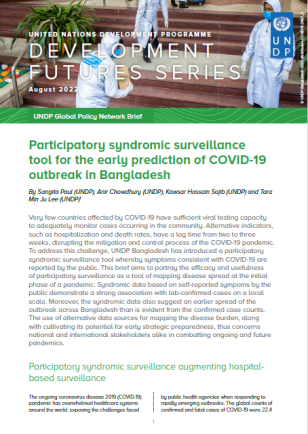Participatory Syndromic Surveillance Tool for The Early Prediction of COVID-19 Outbreak in Bangladesh

Participatory Syndromic Surveillance Tool for The Early Prediction of COVID-19 Outbreak in Bangladesh
pdf (1MB)
DownloadParticipatory Syndromic Surveillance Tool for The Early Prediction of COVID-19 Outbreak in Bangladesh
August 3, 2022
Very few countries affected by COVID-19 have sufficient viral testing capacity to adequately monitor cases occurring in the community. Alternative indicators, such as hospitalization and death rates, have a lag time from two to three weeks, disrupting the mitigation and control process of the COVID-19 pandemic. To address this challenge, UNDP Bangladesh has introduced a participatory syndromic surveillance tool whereby symptoms consistent with COVID-19 are reported by the public. This brief aims to portray the efficacy and usefulness of participatory surveillance as a tool of mapping disease spread at the initial phase of a pandemic. Syndromic data based on self-reported symptoms by the public demonstrate a strong association with lab-confirmed cases on a local scale. Moreover, the syndromic data also suggest an earlier spread of the outbreak across Bangladesh than is evident from the confirmed case counts. The use of alternative data sources for mapping the disease burden, along with cultivating its potential for early strategic preparedness, thus concerns national and international stakeholders alike in combatting ongoing and future pandemics.

 Locations
Locations